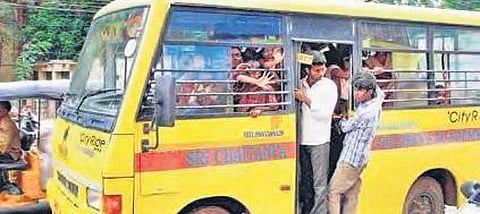

NEW DELHI: In 2015 alone, as many as 15,633 students were killed in road accidents across the country. The toll is more than seven times of the lives lost in crimes against children, including murder and foeticide. Road accidents involving school buses are frequently reported even today in India.
One way out to cut down these tragedies is the implementation of the Intelligent Transport System. It facilitates the movement of schoolchildren during boarding and alighting to and from school buses in a safer way.
There are many factors that cause problems in the supervision of the regularity of students when they enter and exit buses. It is a difficult job for a driver/supervisor to control and manage the entry and exit to the vehicle at the bus stops. The phenomenon of overlooking the safety of kids on the bus is increasingly becoming a problem for the children as well as their parents.
It is here that a system which can record the entry and exit of children can help in bringing more security and safety in school buses. This will bear a positive impact on students, their families and school management system.
Recently, the system was tested at few places which helped school managements to function efficiently. It provides useful information about the children to authorized personnel through SMS using GSM. The system had two main units — the bus and the school itself. The function of the bus unit system is to detect a child’s movement through a reader when the students’ bags embedded with passive tags are detected during boarding and alighting.
The message is communicated to the school unit through GPS and a modem. The RFID reader — comprising an antenna, transceiver, processor, power supply, interfaces with a host computer (i.e. via serial port, or Ethernet) — sends the information to a server which is maintained at the school unit. Each entry and exit activates the RFID tag designed with an antenna, a transceiver, and an Integrated Circuit (IC) with memory. The RFID tag’s performance is assessed by factors such as IC technology, the read/write capability, the radio frequency, the read range, and external factors such as environment and packaging. Ultra High Frequency (UHF) RFID readers (868-870 MHz) are primarily chosen due to their capability of a longer read range (>3 meter) with a faster speed.
The school unit collects data from all the buses, adds them to the system database, checks if there are missing children, and sends a text message to their parents accordingly. Since passive RFID tags are inactive unless they are close to the tag reader, they pose no harm to children. Although the operating distance is limited to the reader’s range, this is an advantage for the system to know who are on board the school bus and to filter out the detected outlier tags easily.
Test results have demonstrated that RFID tracking technology is a feasible option for monitoring and tracking children who travel on school buses. Field trials and experiments have already proven that RFID tags work well under different conditions. Various readings obtained were consistent. Most of the reports are promising. Keeping all these factors in mind, it is necessary to gradually adopt RFID-based tracking technology for boosting safety for schoolchildren in India.
Prof. PK Sarkar
director, Asian Institute of Transport Development